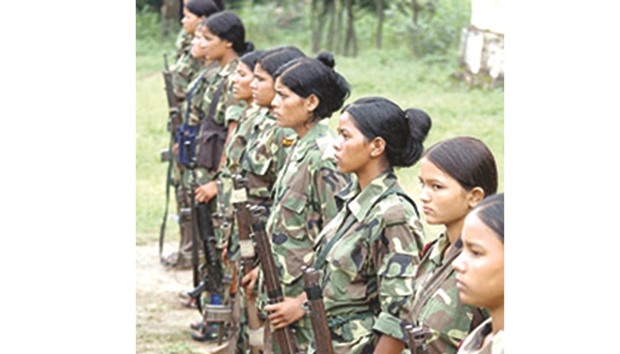Down a narrow, stone-paved alley near Kathmandu’s bustling Ring Road, 27-year-old Rajani Bhandari sits in a ground floor room looking through old photographs of herself in combat fatigues holding an automatic rifle.
The crammed, low-ceiling room of the rundown house has two beds, a cupboard and little else.
A small television is perched on a table in a corner of the room, which barely has enough space for her family of three, including her husband and three-year-old son.
Bhandari doesn’t have a kitchen.
She cooks her meals in the doorway.
Bhandari’s story echoes that of tens of thousands of struggling families in this teeming city of 4mn people.
But hers is also an extraordinary tale: as a girl she was lured from her home in central Nepal by the Maoist promise of a
revolution.
The 10-year insurgency, which pitted Maoist fighters against state security forces with the goal of establishing a communist regime, ended in November 2006 when the Maoists signed a peace deal and joined parliamentary politics.
But a decade after the end of war, thousands of female ex-fighters like Bhandari are still struggling to reintegrate into society.
After spending her early years as a domestic worker in Panchkhal, a town near her home in central Nepal, Bhandari, then just 15, was persuaded by local Maoist cadres to join the
insurgents.
She was impressed by their call to end the exploitation of child workers and to fight against practices such as dowry, a tradition in which a bride’s parents give money or property to a groom’s family.
“They said their fight would help achieve equality and change, that they would end violence against women,” she said.
But after a year of fighting, victory no longer seemed possible, and Bhandari found herself with hundreds of fighters in the hilly village of Kamidanda in Kavre district, as Maoist leaders negotiated peace with the government in Kathmandu.
Tens of thousands of former fighters were provided with retirement packages of up to 800,000 rupees ($7,400). But around 4,000 ex-fighters, including Bhandari, were deemed unfit for the scheme, leaving them with few skills and limited financial support to rebuild their lives after the war.
At the peak of the war, the Maoists boasted that 40% of their fighters were women.
Today, rights activists say many of them face significant barriers as they re-enter
civilian life.
Mohna Ansari, a spokesperson for the National Human Rights Commission, said women were marginalised at the outset of the peace process as they were not invited to the negotiating table.
“Men will never raise the issue of women. There’s a structural problem in our society. Women themselves have to raise our voices and fight for our rights,” she said.
During her visit to one of the former makeshift Maoist camps, Ansari recalled seeing women fighters attending to their babies while their male counterparts took part in
military training.
“The male-dominated society placed a lot of responsibility upon women.
There is a lot of pressure on women,” she said.
Leela Sharma Asmita, a former Maoist commander, grew up in a large, politically conscious family in Deukhuri valley in mid-western Nepal, dreaming of becoming a school teacher.
Inspired by her elder sister, herself a Maoist and married to a regional party leader who was killed in the war, Sharma joined a training camp in a rural hamlet near her home at age 17.
She began to work for the underground party, spreading its ideology and seeking new recruits among the rural population.
In September 1997, she narrowly escaped death when the house she was holed up in with fellow party cadres was raided by security forces.
Sharma, who heads the Former PLA Women’s Academy, which looks after retired women fighters, said hundreds of her fellow former fighters are frustrated by the flawed policies that have failed to address the needs of war veterans.
“Women have special needs. Hundreds of them got married with their fellow guerrillas in the camps and gave birth to babies. But the state and our party failed to address their
grievances,” said Sharma.
She said the state should provide financial support to former fighters and their children, as well as healthcare, education and vocational training.
Things began to change after the Maoists entered mainstream politics and pushed for greater representation of women in state institutions, a milestone in deeply patriarchal Nepal.
While such initiatives have helped a handful of women succeed in Nepal’s rigid political structure, it has not trickled down en masse to former female fighters like Bhandari.
“Our party taught us to fight for people, to raise our voices and to not tolerate injustice.
But now, our main concern is bringing food to the table and giving a decent education to our son,” she said.

Women constituted 40% of the Maoist army during its 10-year insurgency against the state in Nepal.
